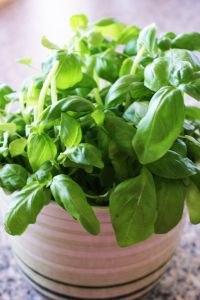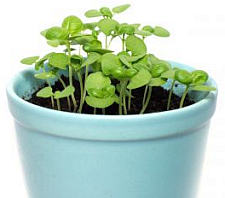Name Origin & Royal References of Basil.
(Ocymum basilicum, Linn.)

Basil history spans over 4,000 years back to the first written accounts mention it was grown in Egypt, possibly for use in embalming.
Greek mythology explains the origin of a portion of basil’s scientific name. Ocimus organized the combats staged in honor of Pallas who ruled Paralia or Diacria and had 50 sons. It is said that when Ocimus was killed by a gladiator, basil appeared.
The second half of the scientific name for basil is derived from the medieval Latin form of the Greek word for “King” or “Kingly”.
The royal reference stems from the basil plant being considered a sacred herb in its native India. Sacred India basil was considered a powerful protector and was often planted around temples and laid with the dead. Once known as the Toolsee plant, basil was held by the Hindus to be sacred to all gods with no oblation being considered truly sacred without the inclusion of basil leaves.
In other countries, basil is also placed with the dead but for a different reason. Basil is often considered a love token and is planted on graves in Iran, Malaysia and Egypt.
However, in Ancient Greece and Rome, basil did not enjoy such a positive reputation and was associated with poverty, hate and misfortune due to the prevailing belief that basil would only prosper where there was abuse. Another of our basil history sources explained that in Ancient Greece, when planting basil seeds, there was much shouting and cursing which later led to the French coining the phrase ‘semer le basilic’ which means to slander.
In Crete, basil was considered an emblem of the devil and was placed on most window-ledges as a charm against his influence.
Basil history, ironically includes its use as a tool in determining chastity – it would wither in the hands of the impure.
Another theory as to basil’s name origin is that sometime in it’s history, basil got confused with the Latin basiliscus (basilisk) which was at one time falsely thought to be an antidote to the venom of that creature. It is thought perhaps for this reason that it was once believed that “Basil is good for the stryking of a se dragon.”
Historically, Basil Was Thought to Be Harmful.
In medieval times, due to basil’s inability to flourish in the presence of Rue, some physicians thought basil was poisonous. Rue was thought to be “an enemy to poisons” and anything that was unable to grow near it was assumed to be poisonous. But, others of the time thought basil was good for “cheering the spirit” and “clearing the brain”.
In a belief that now seems utterly ridiculous, in the 1500s, some physicians believed that by simply smelling basil scorpions would grow in the brain. The scorpion theory can be traced to the writings of an English physician who, while in Italy, observed that if basil were placed under a stone in a moist place, a scorpion would be produced in two days’ time. There’s also at least one anecdotal reference by another “learned physician” to a patient having succumbed to scorpion infestation in his brain brought about by frequently smelling the herb.
The history of basil takes another strange twist around the 17th century. Women at a table would refuse to eat from any dish if a basil leaf had been placed under it. Their aversion to basil was so strong that they would instinctively know the basil was present even if they could not see it. Our source did not explain the origin or cause of this aversion.
Basil was also thought to have transformative abilities. Lord Bacon in his “Natural History” wrote that basil, when exposed too much to the sun, would change into wild thyme.
Migration of Basil.
Basil was not introduced in Britain until the 16th century and they in turn brought it to North America.
Modern Basil History.
In a book first published in 1956, the author proclaimed that basil was only being grown by a “few adventurous gardeners” and had become rather uncommon. How lucky for all of us that she was wrong.
Additional Basil Facts

What to learn more about growing and using basil? How about the different varieties of basil?
Learn how to grow basil from seed with our guide to growing basil. In it, you will also learn how large the plant can grow, how far to plant them apart in your garden, when the leaves should be harvested for optimum flavor and aroma, and common uses of basil.
Our basil companion planting guide will help you to plan your garden and how to strategically plant herbs that help each other and entice beneficial insects to call your garden home. Historically, most companion planting guides only discussed flowers and vegetables, though we include them too, the focus here is on companion planting with herbs.